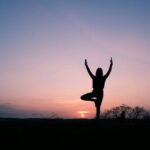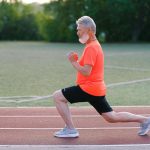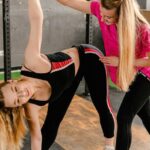Balance is an essential component of health and an important aspect of maintaining a high quality of life at any age. It enables individuals to walk without assistance, climb stairs, and participate in sports. As balance tends to decline with age, incorporating balance exercises into a regular workout regimen can be incredibly beneficial. These exercises help to train the body to control and maintain its position, whether in motion or at rest, which is critical for day-to-day activities.
Stretching, when paired with balance exercises, further enhances stability by improving flexibility and range of motion. This combination can help prevent falls and the injuries associated with them, particularly in older adults. Balance stretching exercises involve a series of movements that require muscle coordination and control, while also promoting muscular strength and joint flexibility. They can be adapted for any fitness level and often do not require any special equipment, making them convenient for most individuals to practice regularly.
Adopting balance stretching exercises as a habitual part of one’s fitness routine may lead to long-lasting health improvements. These exercises support functional fitness, which is the ability to carry out daily activities with ease and without pain. Through regular practice, balance stretching exercises can improve posture, reduce the risk of musculoskeletal injuries, and ultimately contribute to sustained independence and well-being.
The Fundamentals of Balance
Balance is a complex system that involves the harmonious interplay of muscles, strength, posture, and coordination. Mastering it is essential for everyday tasks and can be particularly useful in combating the natural decline associated with aging.
Understanding Balance and Stability
Balance relates to an individual’s ability to maintain their body’s center of gravity within its base of support. Stability is achieved through various muscle groups working in concert, where the strength of these muscles plays a critical role. Posture, or the alignment of body parts, is foundational to balance and influences the effectiveness of balance exercises.
Importance of Balance Training in Daily Life
Daily life demands balance and it becomes increasingly important as one ages. Balance training can enhance stability and reduce the risk of falls. It is not only crucial for older adults but also provides a substantial benefit for all age groups, aiding in daily activities such as walking, climbing stairs, and performing household chores.
The Role of Muscles in Maintaining Balance
Muscles act as the body’s stability anchors, where coordination between muscle groups facilitates smooth movements. Core and lower-body strength are particularly important in maintaining balance. Exercises that target these muscle areas can improve postural stability and support safe movement through daily life.
Prevention of Falls
Falls are a major concern, particularly for older adults, as they can lead to serious injuries. Prevention strategies, including exercise, can mitigate this risk by improving strength and balance.
Risk Factors for Falls
Falls can occur for various reasons, but they are more common among older adults, especially those with conditions such as arthritis. Key risk factors include reduced muscle strength, impaired balance, and a lower ability to stand on one leg, which can significantly affect stability.
- Age: The likelihood of falling increases with age.
- Medical Conditions: Conditions like arthritis can impair stability and movement.
- Balance Issues: Difficulty in maintaining balance greatly increases fall risk.
Exercises to Reduce the Risk of Falling
Implementing targeted exercises can substantially decrease the risk of falls by enhancing balance and muscle strength.
- Balance Exercises:
- Stand on One Leg: Hold onto the back of a chair and lift one foot off the ground, maintaining balance for as long as possible, then switch to the other leg.
- Heel-to-Toe Walk: Place the heel of one foot directly in front of the toes of the other foot and walk in a straight line, which can improve coordination.
- Strength Training:
- Chair Squats: Stand in front of a chair and lower down as if to sit, then stand back up to build leg strength.
- Toe Stands: Rise onto the toes while standing, hold for a few seconds, then lower back down to strengthen the lower legs.
Regular performance of these exercises can bolster an individual’s ability to prevent falls, crucial for maintaining independence and health.
Balance Exercises for Beginners
For individuals beginning balance training, starting with simple routines and basic movements can lay a strong foundation. Balance exercises enhance stability and prevent falls, which is crucial for all age groups, especially older adults.
Simple Stretching Routines
They should take a comfortable stance with feet hip-width apart and engage the core. From this position:
- Flamingo Stand: Stand on one leg, grasp the other ankle behind you, and hold for 15 to 30 seconds. Switch legs.
- Side Reach: Extend one arm overhead and lean to the opposite side, stretching the side of the body. Hold for 15 seconds, then switch sides.
These stretches prepare the muscles for more active exercises by increasing flexibility and promoting better posture.
Basic Balance Movements
- Heel to Toe: Place the heel of one foot just in front of the toes of the other foot, as if walking a tightrope. Focus on a spot ahead, and walk 15 to 20 steps.
- Single-Leg Balance: Lift one foot, hold for 30 seconds, and then switch to the other foot. Use a chair or wall for support if needed.
Incorporating these movements daily can significantly improve stability and are a key component of balance training programs. It is recommended to perform these exercises in a safe environment, initially with support if necessary, progressing to freestanding as one’s confidence and balance improve.
Advanced Balance and Strength Workouts
This section demonstrates how to elevate one’s workout regimen by incorporating advanced techniques that challenge balance and build strength effectively.
Incorporating Weights and Resistance
In advanced balance workouts, adding weights and resistance can significantly increase muscle engagement and strength-building potential. One effective exercise is the single-leg dumbbell deadlift. To perform this, an individual stands on one leg, holding a dumbbell in the opposite hand, and hinges at the hip to bring the torso forward and the dumbbell towards the ground. This exercise not only strengthens the hamstrings, glutes, and lower back but also improves balance and core stability.
- Weighted Plank: For core strengthening, a weighted plank is highly beneficial. Placing a light weight plate on the back while maintaining a plank position intensifies the exercise, targeting the abdominal muscles, lower back, and shoulders.
Challenging Stability Exercises
To further enhance one’s stability, specific exercises that disrupt equilibrium can be introduced. Stability can be challenged by using equipment such as a BOSU ball or balance board.
- BOSU Ball Squats: By performing squats on an unstable surface such as a BOSU ball, individuals recruit more stabilizing muscles, thus improving balance and overall strength.
- Balance Board Lunges: Lunges on a balance board require the body to maintain stability while the board tilts, engaging the leg muscles, core, and stabilizers around the ankle.
These advanced exercises should be approached with caution and integrated progressively to prevent injury and ensure proper form.
Specialty Balance Programs
Specialty balance programs often encompass activities like yoga and tai chi, which are renowned for enhancing stability and flexibility, as well as sports-specific drills designed to boost athletic performance. These programs are tailored to improve coordination and prevent falls, making them beneficial for individuals across various age groups and athletic levels.
Yoga and Tai Chi for Balance
Yoga is a versatile discipline that enhances balance through a variety of poses that focus on strength, flexibility, and stability. Regular practice can lead to improved proprioception, which is the body’s ability to sense its position in space. Specific poses known for their balance benefits include:
- Tree Pose (Vrikshasana): Promotes leg strength and stability.
- Warrior III (Virabhadrasana III): Targets the core and improves focus.
Tai Chi, a gentle form of martial arts, emphasizes slow and deliberate movements, deep breathing, and mental focus. Practitioners benefit from increased muscular strength and flexibility, which are crucial for maintaining balance. Tai chi movements are often recommended for seniors as they can be adapted to varying levels of ability and help reduce the risk of falls.
Sports Specific Balance Drills
Athletes often engage in drills tailored to the specific demands of their chosen sport to improve balance, coordination, and overall performance. These drills can vary significantly but share a common goal: to challenge the body’s ability to maintain stability under dynamic conditions. Examples include:
- Soccer: Using a Bosu ball for single-leg stance exercises to mimic the unstable conditions on the field.
- Basketball: Agility ladder drills that enhance foot coordination and spatial awareness.
By incorporating these specialty balance programs into their training routines, individuals can experience improvements in balance, reduce the risk of injury, and enhance their athletic capabilities.
Adapting Balance Training for Older Adults
Balance training is essential for older adults seeking to maintain independence and mobility. It incorporates a range of exercises designed to strengthen the muscles that help prevent falls.
Modifications for Safety and Effectiveness
For older adults, ensuring safety during balance exercises is paramount. Exercises can be modified to reduce the risk of falls and to accommodate any physical limitations. Here are some targeted adjustments:
- Single-leg stance: Initially performed near a sturdy chair or a counter to hold onto if needed.
- Narrow-stance reaches: Keep a chair within reach to provide support if needed.
- Heel raises: Begin holding onto a solid surface before progressing to unsupported raises.
The National Institute on Aging recommends incorporating physical activity into daily routines safely. Balance exercises adapted for seniors involve lower impact and may include the use of assistive devices or modifications in movement amplitude to accommodate joint health and stability concerns.
Focus on Mobility and Independence
Maintaining mobility and independence is a key goal of balance training for older adults. Specific exercises are selected to achieve this objective:
- Standing marches: Performed while holding on to a stable surface, progressing to unassisted as confidence improves.
- Mini lunges: Start with shallow lunges and increase depth as strength improves, always ensuring stability.
- Lateral stepping: Begin with small steps, gradually increasing distance while maintaining form.
These activities foster muscle strength and coordination, which are crucial factors in daily living tasks. Regular physical activity, adapted to the individual’s abilities, supports long-term mobility and independence, which are central to a high quality of life in older adulthood.
Understanding and Improving Posture
Good posture is essential for balance and overall health. It involves the proper alignment of the body’s various parts, supported by the right amount of muscle tension against gravity. Without posture and the muscles that control it, individuals would simply fall to the ground.
Exercises to Enhance Posture
A regular routine of exercises can strengthen the core and back muscles, leading to better posture. Importantly, they target muscle imbalances that can pull the body out of alignment.
- Shoulder Blade Push: This exercise strengthens the muscles around the shoulder blades and upper back, helping to counteract the rounded shoulders often seen in poor posture.How to Perform:
- Lie on your back with knees bent.
- Push the shoulder blades down and together.
- Hold for a few seconds, release, and repeat.
- Bird-Dog Exercise: Improves core stability and encourages spinal alignment.
**Execution**: 1. Start on hands and knees. 2. Extend opposite arm and leg simultaneously. 3. Hold for several seconds, then switch sides.
The Connection Between Posture and Balance
Posture is intrinsically linked to balance. Good posture distributes weight evenly, reducing strain on any one part of the body and making balance easier to maintain.
- Core Strength: A strong core stabilizes the torso, which is central to both good posture and balance. Core exercises, such as planks, enhance this strength.
- Back Alignment: Correct alignment of the spine is critical. Exercises like cat-cow stretches can help align the back and promote a more balanced posture.Detailed Steps:
- Start on hands and knees for Cat position—round the back by pushing the middle of the spine upward.
- Transition to Cow by lifting the head and tailbone, creating a dip in the lower back.
By integrating exercises that build core and back strength, proper posture becomes more natural, enhancing balance and reducing the risk of injury.
Engaging in Regular Balance Workouts
Regular balance workouts are key to maintaining stability and coordination, especially as one ages. A well-structured routine can be both fun and engaging, incorporating elements of cardio and active exercises that can be tailored as per individual needs.
Establishing a Consistent Routine
A consistent balance workout routine is essential for achieving lasting benefits. Individuals should plan to include balance exercises into their workouts at least three times a week. These sessions can be short, about 15-20 minutes, and should be engaging enough to keep the practice enjoyable. A variety of exercises should be used to keep the mind and body active, with progression over time to maintain challenge and interest. Consulting with a physical therapist can help tailor a routine to one’s specific needs, ensuring correctness of form and safety.
Measuring Progress and Adjusting Exercises
Tracking progress is crucial for motivation and for assessing the effectiveness of the routine. One can measure progress through simple methods such as:
- Time: Holding a balance position for a longer period indicates improvement.
- Complexity: Incorporating movement or weights into a balance pose can indicate a higher skill level.
As one advances, adjustments to the routine should be made to provide the right level of challenge. This could involve increasing the duration of exercises, introducing new balance exercises, or integrating more cardio components to enhance overall fitness. It is important to listen to the body and adjust accordingly, preventing overexertion and potential injury.
Additional Balance Considerations
When addressing the topic of balance exercises, it is critical to consider factors beyond physical movement. Cognitive influences and the use of specific equipment can significantly impact one’s balance training effectiveness.
Cognitive Factors and Balance
The brain plays a crucial role in maintaining a person’s sense of balance. Cognitive functions such as concentration and spatial awareness are integral to performing balance exercises. They often require the brain to process inputs from the eyes and the ears, which work together to keep the body aligned and upright. An individual’s ability to focus can be as significant as their physical capability when executing balance exercises.
Equipment and Aids for Balance Training
Balance training can be enhanced with the utilization of specific equipment:
- Bosu Balls: Stepping onto the flat platform of a Bosu ball requires the body to adjust and find the center of gravity, engaging core muscles to maintain an upright posture.
- Medicine Balls: Holding a medicine ball while performing balance exercises adds a level of difficulty and engages various muscle groups to retain stability.
Using such aids not only makes exercises more challenging but also helps to improve proprioception and muscle activation during balance training.








